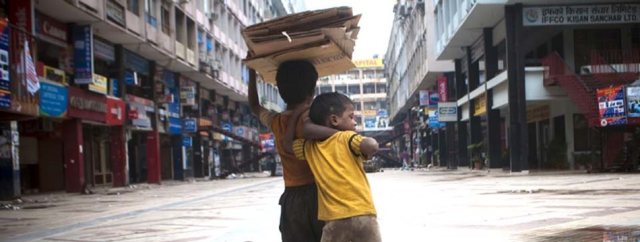
Street Child toiling hard
Our national and state governments often talk about reaching out to the very last person, to the most marginalized, in their policies, agendas and plans. Every achievement is cited to be a milestone in the ultimate destination of development reaching out to the last person. The pertinent question: is every step of our government really a move towards reaching out to the last person, to make even a small difference in the lives of those who are farthest to reach? Let us explore this question with regards to one of the most vulnerable and marginalized groups in India that is Street Children.
Street children are a common sight on every other red light of big Indian cities as with disheveled hair and shabby clothes either begging or selling pens, toys, or other items they often come across to us when our cars come to a screeching halt on red lights. However the irony is that in our policies and plans Street Children are invisible. Their absence in the mind space of policy makers and our leaders is evident from their poor access to basic services.
Lack of Identity Documents: Identification documents like the UID or birth certificates is the legal right of a child and has been mandated by the Article 7 of UNCRC which states, “The child shall be registered immediately after birth and shall have the right from birth to a name, the right to acquire a nationality and as far as possible, the right to know and be cared for by his or her parents.” According to UNICEF, “Apart from being the first legal acknowledgement of a child’s existence, birth registration is central to ensuring that children are counted and have access to basic services such as health, social security and education”. Street Children face humongous challenges in accessing their social, economic and civil rights. Lack of identity deprives them of basic facilities such as health centres, proper nutrition and right to play among others. Large proportion of street children in urban areas do not have identity documents.
According to a study titled as ‘Life on the Street’ conducted by Save the Children in 2015 in the cities of Lucknow, Mughalsarai, Patna, Greater Hyderabad and Kolkata-Howrah found that majority of street children do not possess any identification document in these five cities. Most common identification documents were unique ID or Aadhar card, birth certificates, ration card, and/or education certificates.
The city-wise analysis of another street child survey[1] conducted by Save the Children in the cities of Hyderabad, Kolkata, Bhubaneswar and Jaipur showed that of the children possessing identity documents, Jaipur has the lowest percentage of children (10.6%; 102 out of 960) as compared to Hyderabad (33.9%; 456 out of 1344), Kolkata (56.3%; 648 out of 1152) and Bhubaneswar (69.7%; 535 out of 768).
Health Issues: Illnesses are quite common among these children. According to a study conducted by the Tata Institute of Social Sciences (TISS) and Action Aid India in Mumbai City about 18 per cent children reported various illnesses. The highest reported illness being fever (9 per cent) followed by skin infections (3 per cent). Needs to be noted that this finding was not based on any medical examination.
Education: Life on the Street Study conducted by Save the Children in five cities found that overall, approx. 63 per cent of the street children were illiterate. The proportion of illiteracy was highest in Lucknow (82 per cent) and lowest in Kolkata- Howrah (52 per cent). Thus, while the Right to Education Act of 2009 guarantees free and compulsory education to children between 6 to 14 years of age, the study clearly indicates that the implementation of the Act has not improved the access of street children to the neighborhood schools.
Open Defecation: Through Government is trying its best to make the country Open defecation free however a large number of Street Children continue to defecate in the open. According to a study conducted by Pune Municipal Corporation and Rainbow Foundation, India as many as 42 percent of Street children defecate in open in Pune city.
The above-mentioned concerns laid out with regards to the plight of Street Children makes one thing very clear that though our successive Governments have been trying to provide basic health, education and sanitation services and also ensuring the identity of every Indian however these have failed to reach the most marginalized amongst us. Therefore there is a need for the government to give a special consideration in schemes and policies to provide access to basic services to Street Children as it is less likely that they will reach the service providers rather service providers need to reach out to them. If India has to become a truly developed country then it cannot turn its face away from those who do not even know that they need to look towards it to improve their lives.
[1] Survey of Street Children in Hyderabad, Kolkata, Bhubaneswar and Jaipur, Save the Children.
This is First of a 3 – blog series on Street Children (1/3). Do read and share your comments and reactions.
Disclaimer: The views expressed are solely those of author in the private capacity and do not necessarily represent the views of employer.
